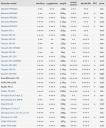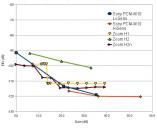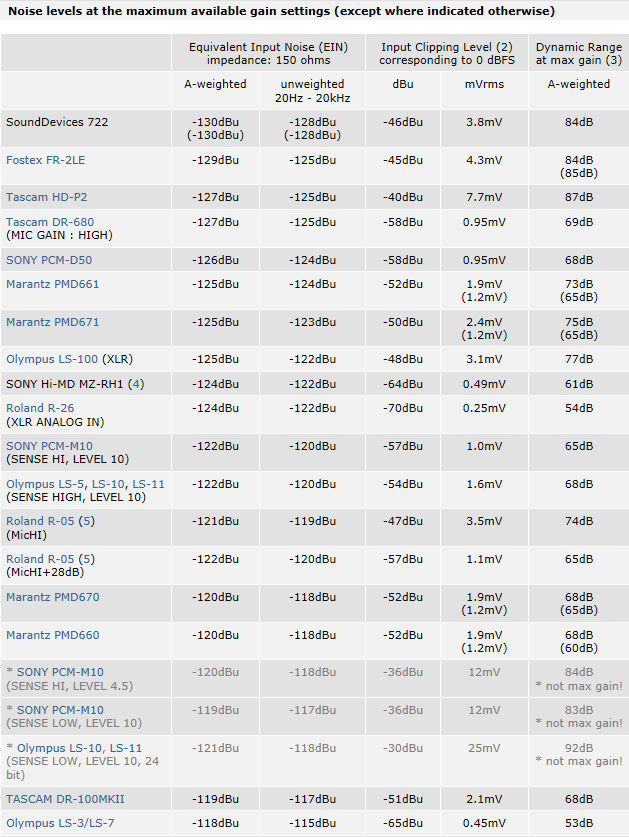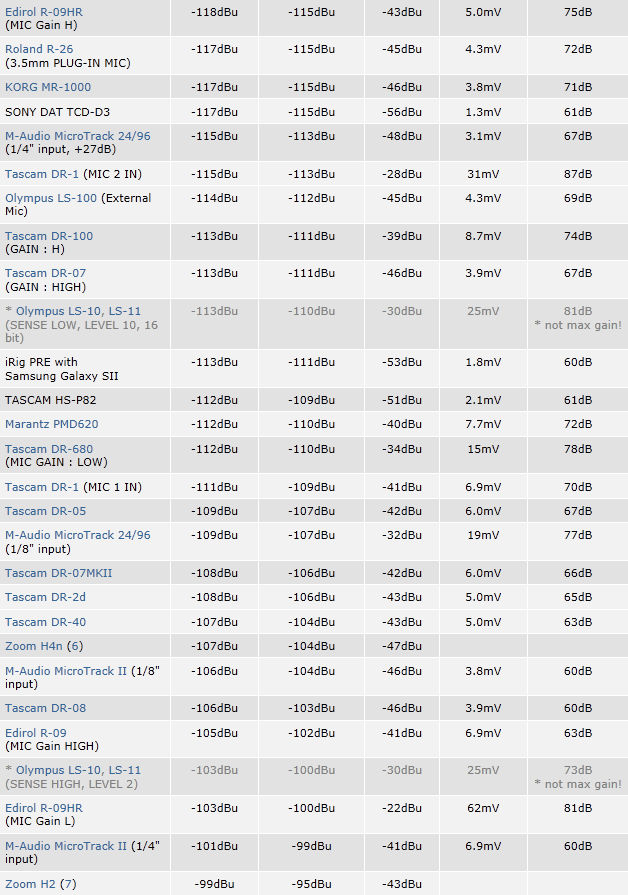
It allows to keep PV going, with more focus towards AI, but keeping be one of the few truly independent places.
-

 recorders.jpg629 x 837 - 153K
recorders.jpg629 x 837 - 153K
 recorders1.jpg628 x 895 - 139K
recorders1.jpg628 x 895 - 139K
 recorders2.jpg598 x 721 - 122K
recorders2.jpg598 x 721 - 122K -
Such a comparison was exactly that, what many people were missing.
Roland R-26 seems to be at least good, no?
-
Yep, most surprising here is how good FR-2LE is.
-
to my recollection the H2 is by no means Zooms strongest performer. Even the H1 outperforms it by quite a bit. The H4N blows it away. I have no allegiance to one company, but it seems odd that there is only one zoom model on the list and it happens to be one of the worst zoom has out.
Edit, just saw the H4n is on the list. Still would be nice to see the H1 on there if the H2 is gonna be included.
-
Fostex makes good stuff. The DC-R302 doesn't get much love, but I think the front end is very clean compared to any of the other camera-mount sound recorders. Its not SD build quality, but what is?
-
The Zoom H1 was measured as having A-weighted EIN of -111 (dBu?) at the maximum gain setting. I could not find figures for dynamic range or the maximum input level before clipping.
-
So the question is, how good is the comparison, and how useful? As far as how good it is, on the same site, using what appears to be more scientific methods, the SD 722 has a measured ein of 128 instead of 130 http://www.avisoft.com/test/noisefloors.pdf Since the theoretical limit of noise is in any case 129.5, any figure over 129.5 should be regarded with a raised eyebrow. Meaning it is BS. "Noise floor below the theoretical limit!" Wow.
So the answer is, it isn't good--that is, the tests aren't something that have a useful margin of error.
The second question, how useful--useful for real work--depends on on how well the units mesh with particular mics, whether you will get a bit less noise with a standalone preamp, how "good" the sound is and whether the noise exceeds the ambient noise floor.
Will you get a bit less noise with a standalone pre like a grace audio? Yes. A very small difference.
Will you get a slightly better sound? Yes, small difference. Note that moving your microphone one foot will make a bigger difference than buying an expensive box. Really.
Are many of the boxes tested above quieter than a typical noise floor (i.e., the noise figure is irrelevant, since the noise will be completely covered)? Yuppers, they are quieter than the noise floor. The mic makes more of a difference than the pre, especially the impedance.
Which one sounds the best? That's subjective. The Fostex is good enough for professional audio work, that's for sure, whether you like the sound is subjective. Most people will buy the wrong one, don't ask me why.
What is missing? What is missing is that many modern systems use a hybrid design in which the AD is coupled directly to the pre. In this case, not only is it impossible to measure the pre noise, even if you could it is not a relevant figure.
Why does the gain knob sometimes get really, really noisy when you turn it up "high"? This is a basic part of the whole preamp BS. You do your research, you read the specs, you buy it, you plug in your mic, you crank the volume and the top end is garbage. And we aren't talking "1dB" of garbage, we are talking dumpster level garbage in the sound, not just noise but weird harmonic colorations, plasticky sounds. Well, that's because a lot of these figures are BS. Shocker. BS in a budget box? Yup. And not just in the budget box. I tested a top brand once--a $4,000 unit--that was junk.
Any pres you can really crank? Absolutely, the digital pres in some of the RME products (Micstasy, FF400), just turn them up. Some of the high end pres have "real gain" as well. You can also pair what you have with a high output mic like the Sennheiser MKH 40, which will give you not only a lower noise floor but an extra 6dB of gain. Again, you won't need it on a live set because the noise floor will be greater than the noise in your gear.
How is noise measured? http://209.68.17.232/appnotes-a/mmpnoise.html Is the "1dB" figure important? Yes, and most pres neither have it nor advertise it. Not only that, if you call them up they would not be able to explain it.
Is there a true audiophile solution that won't break the bank? Actually, there is. You can buy a Grace Stereo pre, a Lavry AD11 or an RME Digital pre and use it as the Front End for a Tascam DR 680. You will get two audiophile channels plus the rock steady clock for your track timing. The Lavry has a real, workable soft-limiter if you need such things. You can try it for a year, and if you don't like it when you sell the pre on eBay you will get your money back, or maybe even more than you paid for it. Cheap for what you get.
-
@balazer - note that the Zoom H1 achieves its best SNR at 37 record level, I verified this here in my own lab. It seems silly to mess around with recorders which are so finicky, but I have bought two -- for size, weight and performance they can't be beat... (IMO, of course).
Here is an interesting graph I found -- SNR vs gain setting for a few recorders...

 Noise_vs_gain.jpg582 x 475 - 23K
Noise_vs_gain.jpg582 x 475 - 23K -
That graph is not SNR vs. gain. It's EIN vs. gain.
Hate to beat a dead horse, but a single gain setting can't possibly give the best SNR for all input signals. If you have clipping at that gain setting, a lower gain setting is surely better. If the recording is very quiet with lots of quantization noise at that gain setting, a higher gain setting is surely better. Internal noise is just one source of noise, and not the only one that affects the SNR.
The one gain setting minimizes the internal noise and maximizes the size of the recorder's dynamic range. But maximizing the recorder's dynamic range without regard to the input level only helps you if you can freely shift the level of the input signal to fit the recorder's range, with an external attenuator or pre-amplifier. If you have a high quality external pre-amplifier, then yes, set the H1's gain to 37 and don't touch it: just use the pre-amp's gain control.
-
@balazer I am happy enough if the noise floor is low enough to be below ambient noise in the recording location -- which I have found it to be with the internal mics and that gain setting, and I have neither seen overload -- but I don't record in discos. Maybe I will get out the sound level meter and quantify exactly what the DR issues are. Frankly, since the noise floor is OK, and I haven't had overload, I have been one happy camper this last year (or so). Set and forget is what I prefer :)
Howdy, Stranger!
It looks like you're new here. If you want to get involved, click one of these buttons!
Categories
- Topics List24,098
- Blog5,725
- General and News1,403
- Hacks and Patches1,153
- ↳ Top Settings33
- ↳ Beginners256
- ↳ Archives402
- ↳ Hacks News and Development56
- Cameras2,401
- ↳ Panasonic995
- ↳ Canon118
- ↳ Sony156
- ↳ Nikon96
- ↳ Pentax and Samsung70
- ↳ Olympus and Fujifilm102
- ↳ Compacts and Camcorders300
- ↳ Smartphones for video97
- ↳ Pro Video Cameras191
- ↳ BlackMagic and other raw cameras149
- Skill1,960
- ↳ Business and distribution66
- ↳ Preparation, scripts and legal38
- ↳ Art149
- ↳ Import, Convert, Exporting291
- ↳ Editors191
- ↳ Effects and stunts115
- ↳ Color grading197
- ↳ Sound and Music280
- ↳ Lighting96
- ↳ Software and storage tips266
- Gear5,420
- ↳ Filters, Adapters, Matte boxes344
- ↳ Lenses1,582
- ↳ Follow focus and gears93
- ↳ Sound499
- ↳ Lighting gear314
- ↳ Camera movement230
- ↳ Gimbals and copters302
- ↳ Rigs and related stuff273
- ↳ Power solutions83
- ↳ Monitors and viewfinders340
- ↳ Tripods and fluid heads139
- ↳ Storage286
- ↳ Computers and studio gear560
- ↳ VR and 3D248
- Showcase1,859
- Marketplace2,834
- Offtopic1,343
Tags in Topic
- comparison 19
- recorders 5












